In Part II and Part III we discussed Art Deco which began in about 1910 and lasted until 1939. Fashions and jewelry styles change gradually over time. From the mid-1930’s, the flat two-dimensional and geometric (Deco) characteristics gradually moved toward three-dimensional and curved forms - and the style that was later called "Retro" or "Retro Moderne" began. Retro was not a "Period" like Art Deco but it developed from and followed the Art Deco movement.
Volutes, scrolls, spirals, domes, and stylized leaves and flowers were the dominant motifs. In about 1937, the supremacy of white metal came to an end and yellow gold came back into fashion on a large scale. However, white metal continued to be used including platinum (in fine jewelry and rhodium in costume jewelry) until it was restricted during the War years, and was used again when the restrictions were lifted.
This Coro "Duette" is in the Retro style:
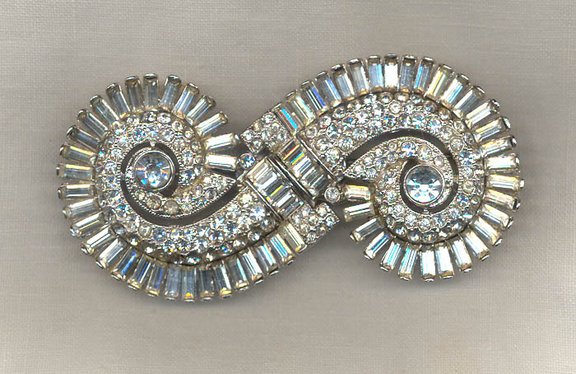
Retro like Art Deco covers a number of different looks. It includes many of the floral enamels that were so popular in the late 1930's and early 1940's, the single large stone pieces, the streamlined gas pipe and tank designs that began prior to WWII and continued throughout the 1940's into the early 1950's. Many of the motifs that were seen both pre-WWII and post WWII are: pieces based on the Van Cleef & Arpels' “Honeycomb” Bracelets, Invisibly set brooches, and Flowerhead Brooches. The "Retro" style continued through the New Look, introduced by Christian Dior in the late 1940's, into the 1950's. The look appeared in fine jewelry and was interpreted in costume jewelry immediately!
During the 1930's several fine jewelry designers emigrated from Europe to the United States and worked for American jewelry companies. Marcel Boucher, who opened his own company in the late '30's worked for Mazer Bros. Alfred Philippe, the head designer at Trifari for many years came to the US from France. Providence, Rhode Island was the "capital" of American Jewelry Production during its heyday.
In the 1930's more and more jewelry designs were patented - which was meant to protect the design from being copied, but had little effect. However, it's a great way for us so many years later to date pieces - if we find a patent number on the piece.
When I first started collecting jewelry "seriously" I found a pretty rhinestone pin in a local antique shop. It was very inexpensive but it really appealed to me. After I got it home, I discovered it had a patent number on it. It's a 1941 rhodium plated Trifari brooch designed by Alfred Spaney. Here's my "great find" - and the patent:
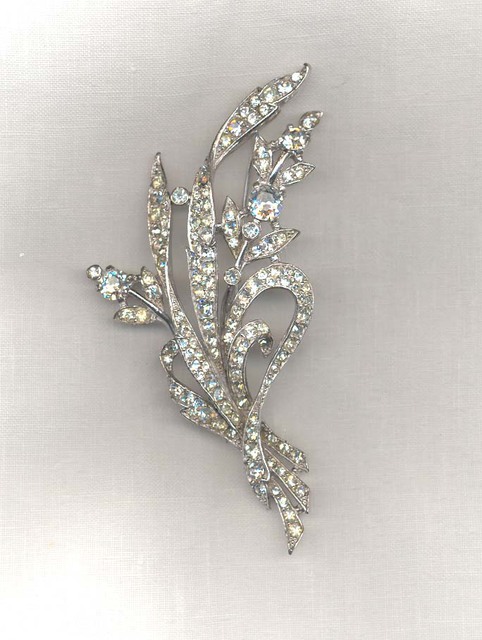
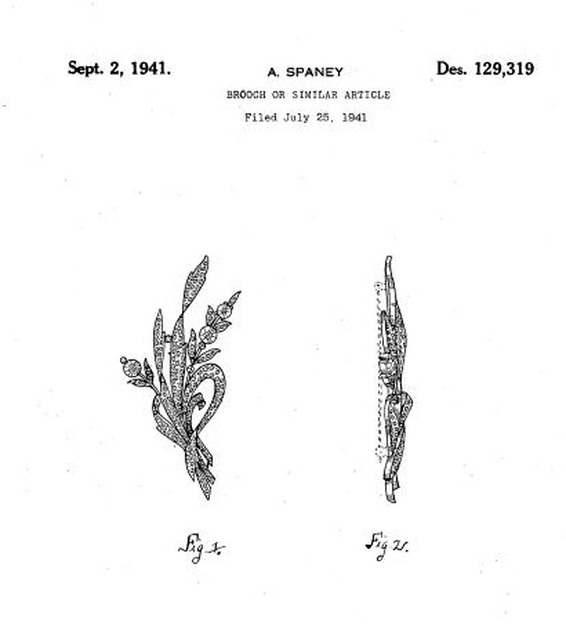
Alfred Spaney was a free-lance designer who did some pieces for Trifari in the early '40's. Most of the Trifari patents are signed by Alfred Philippe who was the chief designer at Trifari for many years. Many of the Coro patents are signed by Adolph Katz who was the head of Design at Coro, but unlike Philippe, he was not a designer. Many of the best known Coro designs were done by Gene Verrecchia who was at Coro from 1933-1963.
In the late 1930's fashion changed - skirts became shorter, some pieces had shoulder pads and were very tailored while some pieces were highly romantic and "retro" in a different meaning of the word - influenced by "Gone With the Wind" which brought about a Victorian Revival in fashion and jewelry.
This is one of the few examples I have of Victorian Revival jewelry. It's a cross between Victorian and Retro in style. It was made by Kreisler and is signed Kreisler USA Quality.
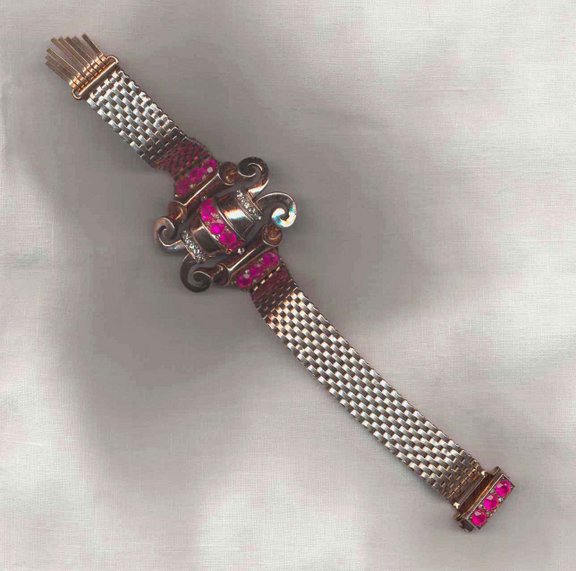
In the very late 1930's - early 1940's costume jewelry makers started replacing dress clips with "pin clips" which are more commonly known as "Fur Clips." This form was used by Cartier in the late 1920's but was not used in costume jewelry until later. Fine jewelry still uses this finding on some pieces but in general it was only used in costume jewelry for a relatively short time and its heyday was the 1940's. Here is an Eisenberg fur clip - front and back showing the prongs:
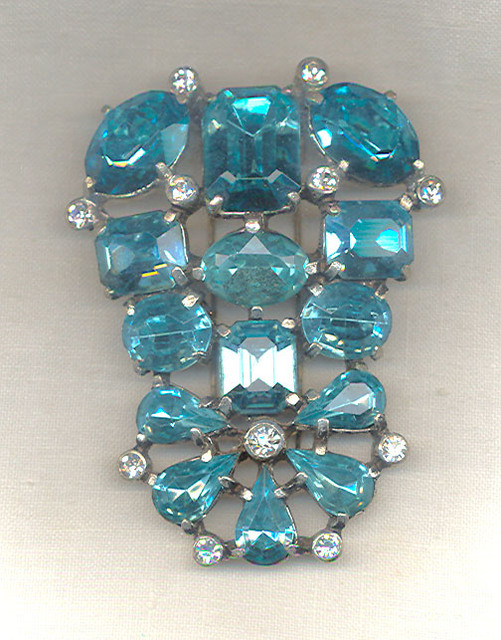
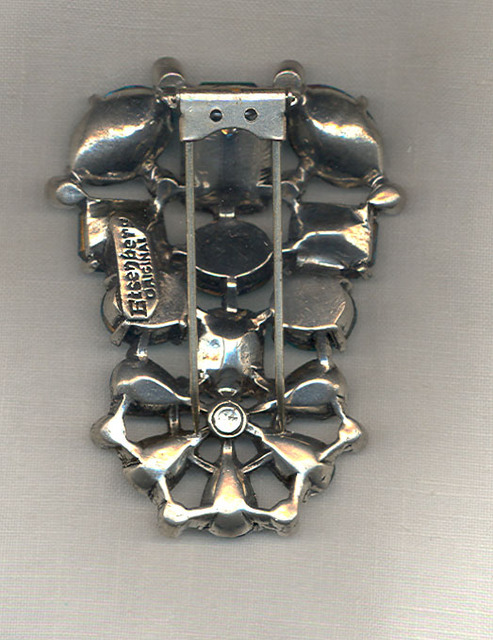
Fur clips were worn on heavy clothing like suits, coats and some dresses. They were not worn on furs, despite the name - the sharp prongs would have ruined the pelts.
In the late '30's and '40's Costume jewelry still mimicked fine jewelry. Here's an Eisenberg ad from 1940:
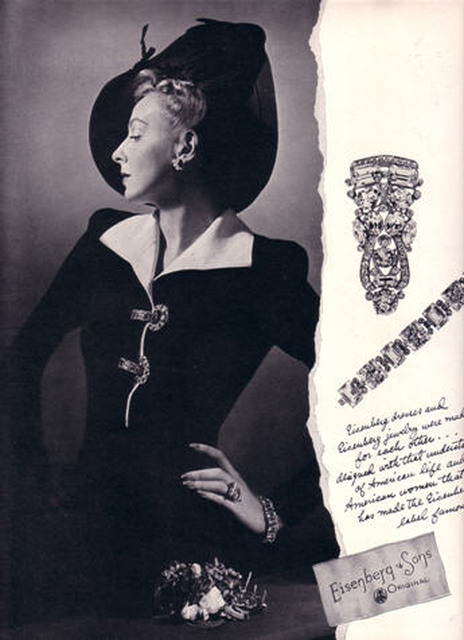
This piece is not signed. It's a dress clip that reminds me of the jewelry shown in the previous ad:
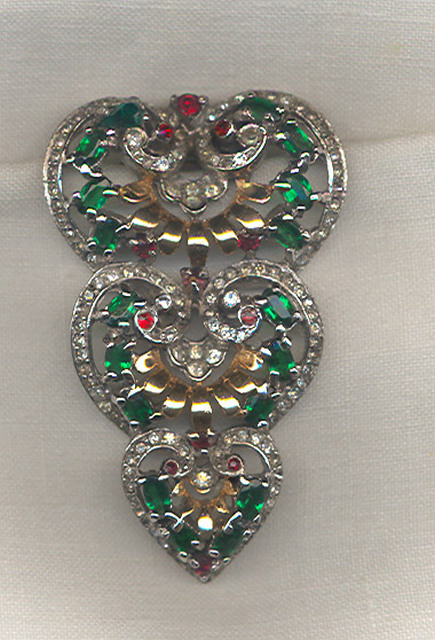
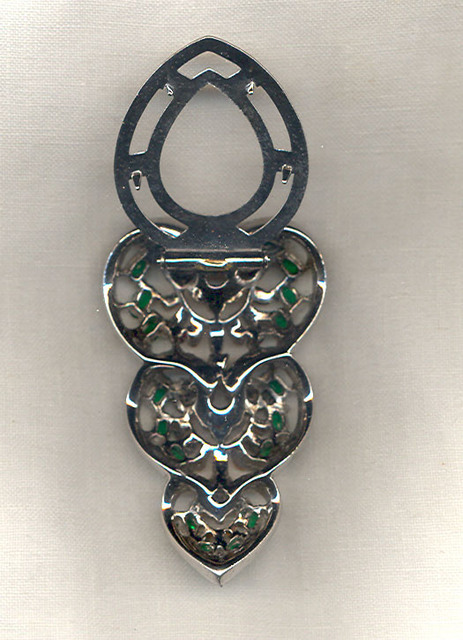
I showed this Trifari Fur Clip, designed by Alfred Phillipe with the patent in the first part of this workshop but here it is larger:
This is D. 119,095 - February 20, 1940:
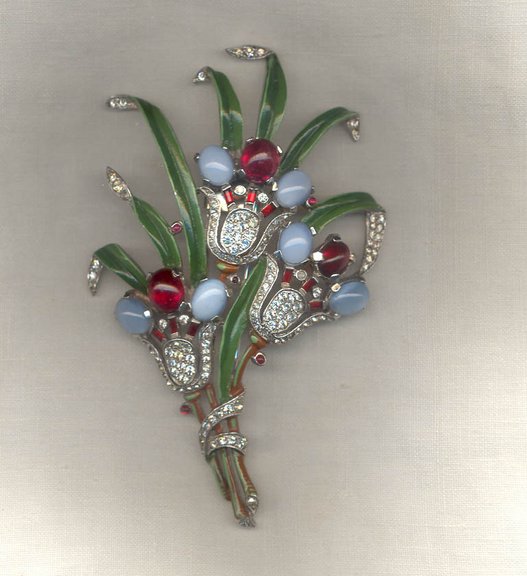
Here's the 1938 Trifari advertisement we looked at in in Part I, and a Coro brooch that is quite similar to those in the ad::
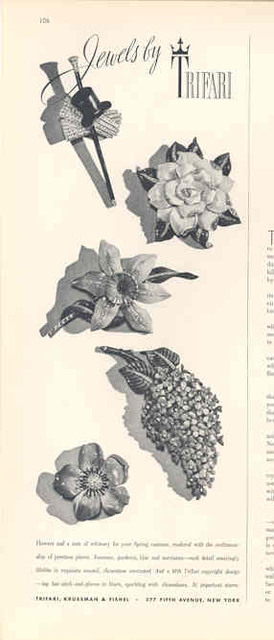
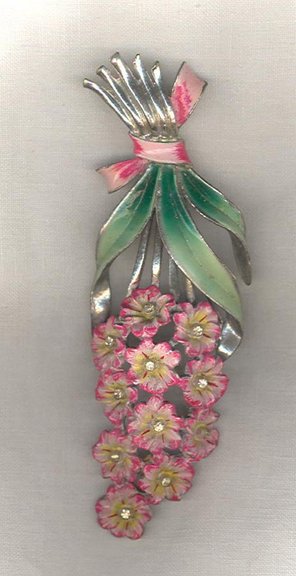
Another very "Retro" styled Floral enamel fur clip probably Coro:
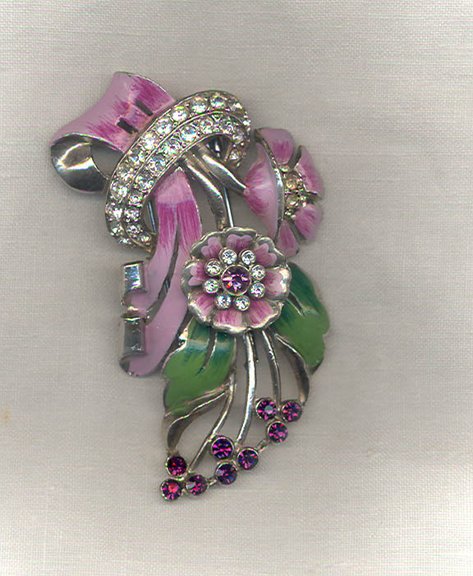
One of my favorite late '30's enameled brooches. It is unsigned and a great example of the Retro style:
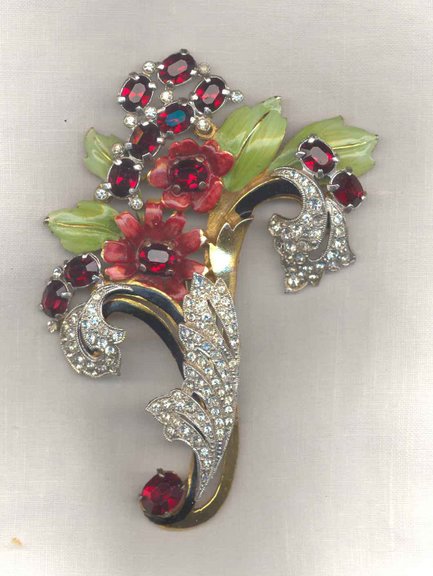
During the late '30's and the early '40's "most" of the jewelry made by the better known companies was signed with the maker's mark or signature - but not all. Trifari was first to advertise that their jewelry was signed. It's more difficult to find unsigned Trifari particularly after the very early '40's. But it is possible to find unsigned pieces by many of the other major companies. Experienced collectors recognize pieces by designs and by the findings - type of dress clip, fur clip, pin catches, etc.
This very large early '40's brooch is not signed but it is recognizable as a variation of a design by Marcel Boucher. It is very similar to the Fuchsia series that he did:
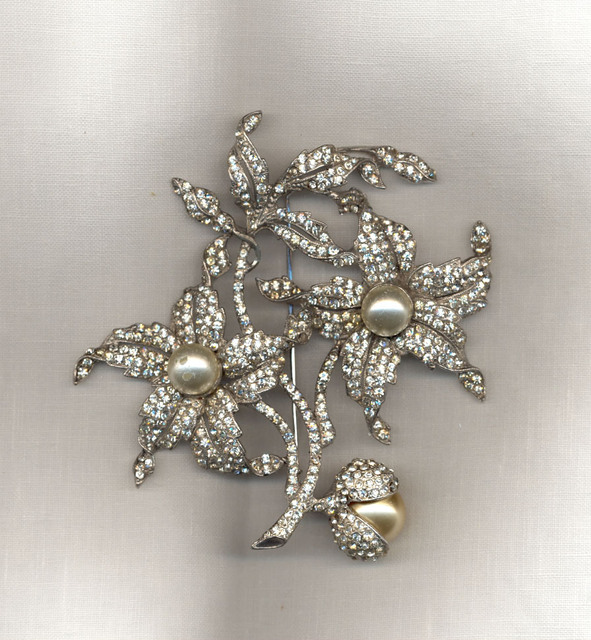
Much of the jewelry of the late '30's and '40's was gold toned. Some of the motifs began prior to WWII and remained popular until after the War. These two bracelets were made by Trifari. The first is signed KTF and was made prior to 1937. The red "ruby" rhinestones are an example of invisibly set stones. The second is signed Trifari. Both are based on the honeycomb design called Ludo Hexagone by Van Cleef & Arpels.
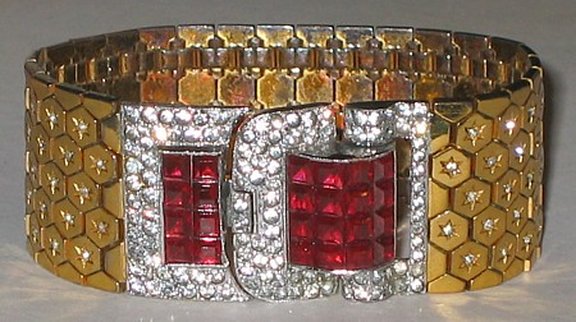

Military themed jewelry like tank bracelets were worn throughout the late '30's and '40's. Gas pipe chains were used both as bracelets and for necklaces. This Retro styled necklace is by Kreisler and is marked Kreisler, U.S.A.
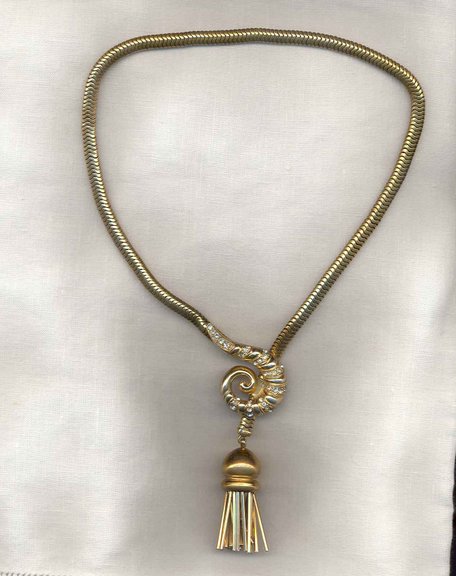
A 1940's set by Boucher. The center part of the necklace is a fur clip that can be removed so the chain can be worn separately -and so can the fur clip!
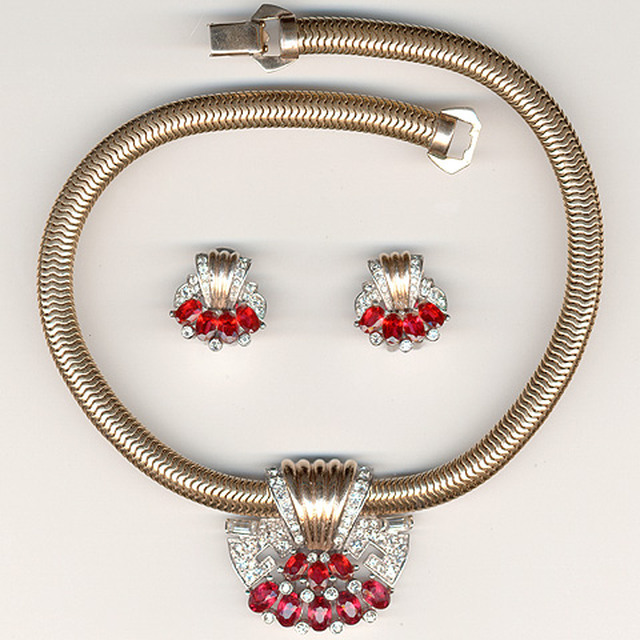 :
:
A "tank" style bracelet. This was originally gold toned and has "lost" its plating! :

Here's another gold-tone '40's bracelet. The design is reminiscent of "tank tracks.":
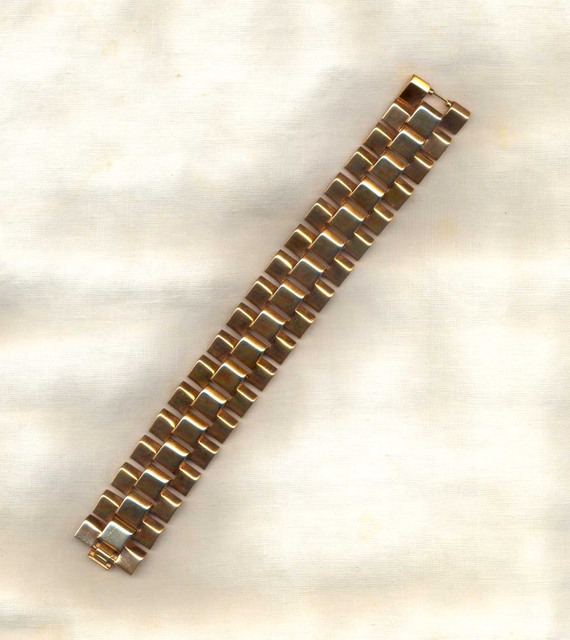
WWII began earlier in Europe than in the US. Some of the raw materials for manufacturing jewelry were in short supply and after the entry of the US into the war, base metals and rhodium plating were restricted for war use. Jewelry was made from other materials. Fine costume jewelry was made of sterling silver which was not restricted, and was often plated, although not all was plated. Jewelry design changed to accommodate the restrictions. Pieces featured one large often unfoiled rectangular cut stone due to the shortage of Austrian crystal rhinestones. Here are some "Retro" brooches from the WWII era:
Note that some of these are in the Red White and Blue patriotic color combination that we discussed in Part I:
Mazer:

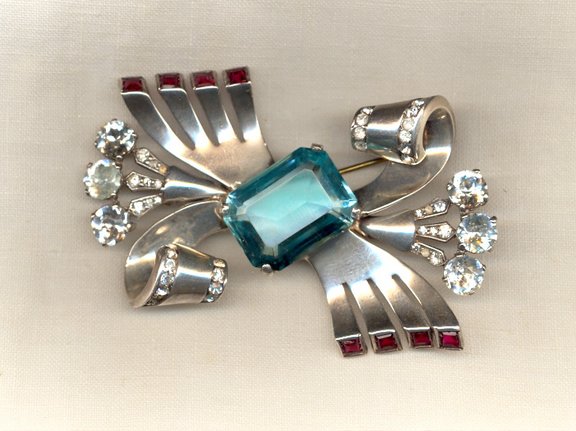
Trifari:
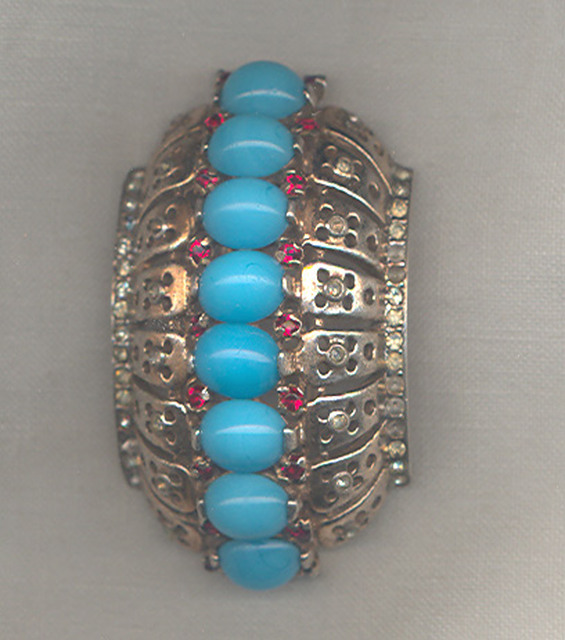
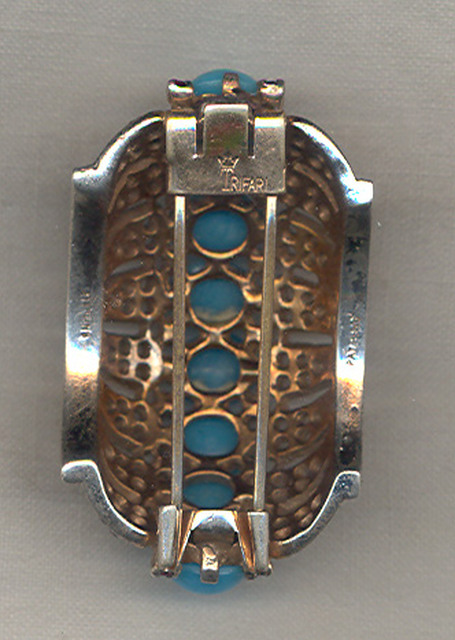
Eisenberg Original:
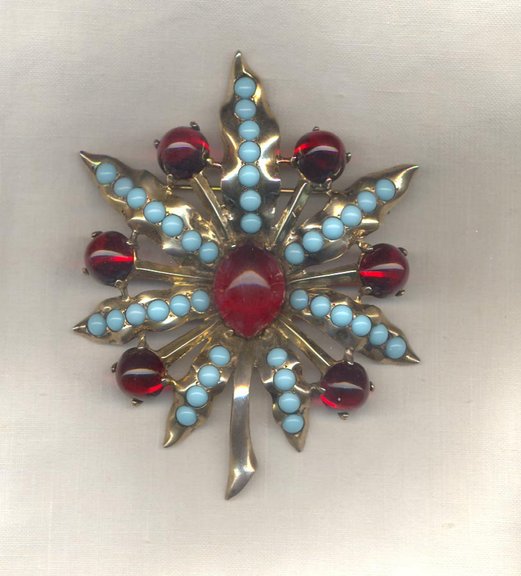
Monet:
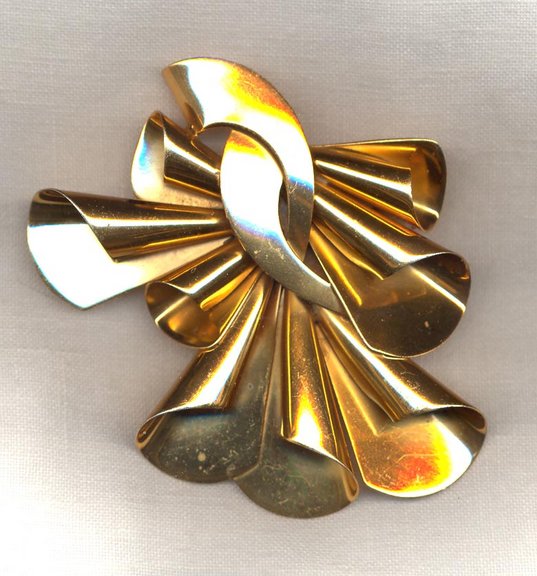
Here's a Hobé Sterling piece:
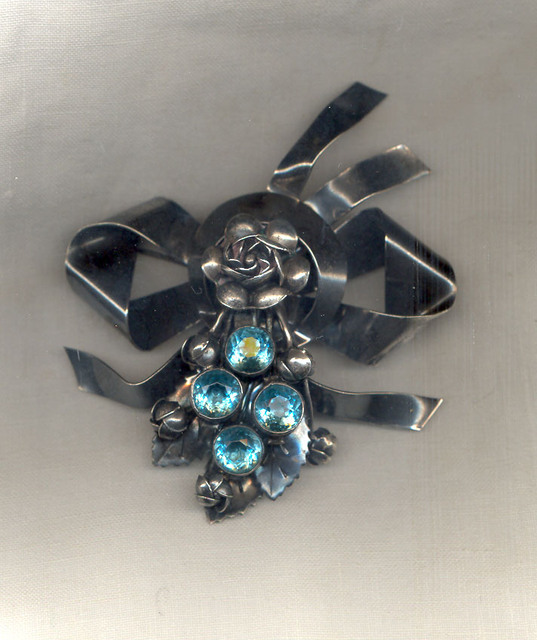
During WWII some jewelry was made in the shape of animals or fish and featured large pieces of Lucite set in sterling. These pieces are now nick-named "Jelly Bellies." The Lucite was left over from airplane windshields! These are highly collectible:
This is a Trifari piece designed by Norman Bel Geddes. The wavy gold things are actually the refection of the fur clip mechanism:
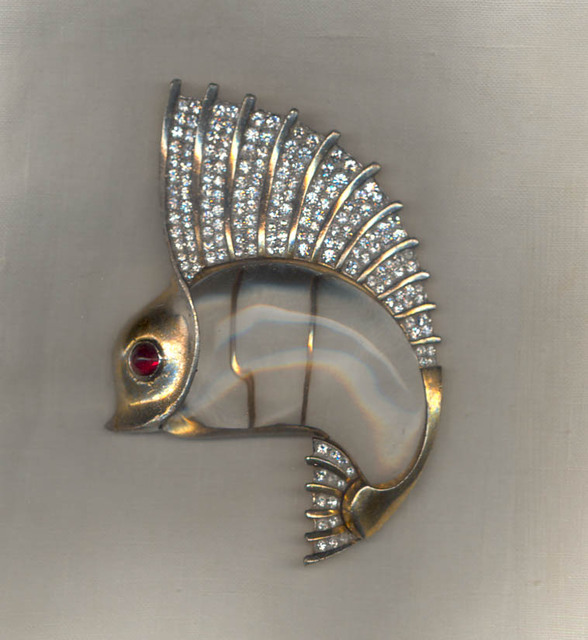
Sterling continued to be used for a few years after the War.
Mazer - 1946
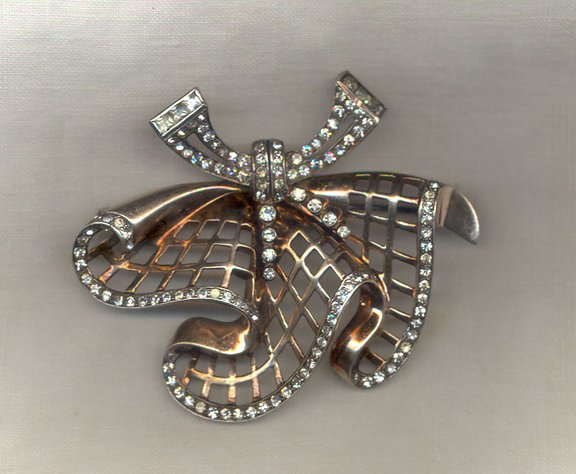
Here's an ad showing this piece and matching earrings:

You may have been wondering why we haven't seen very many matching "sets" or parures so far. The tendency to abandon parures started in the late 19C. and continued to the 1940’s. Pieces of the same style & materials, but not the same design were worn together. Parures were worn again in the 1930’s – but not in a big way. Matching sets came back on a large scale in the 1940’s.
Many vintage costume jewelry collectors have what is called SCS - "set completion syndrome" and look for all the pieces of a set - bracelet, necklace, brooch and earrings.
We haven't discussed fashion as much in this section as in previous sections. Most of you are aware that during WWII there were restrictions on how much fabric could be used so clothing that was produced either by manufacturers or at home was very influenced by wartime regulations. Again many women were in the work force - fashion was influenced by military themes and was shorter and straighter . Big shoulder pads were popular and some military motifs like epaulets were used. Woman also had to "Make do and Mend" - and older clothes were worn, shortened and stocking seams were painted on the back of the legs because nylon was used for parachutes.
People were very creative making do with jewelry as well. Jewelry was made of wood, plastic stones were used and due to the shortage of metal, even construction methods were altered. Here is a Miriam Haskell dress clip made of plastic.

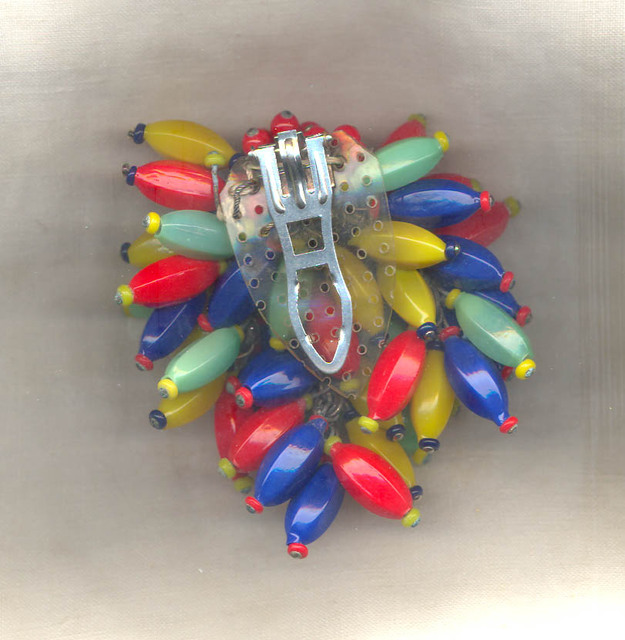
In the first part of the workshop we looked at some patriotic jewelry from WWII. The plastic stones were used because the crystal and glass stones from Austria and Bohemia were unavailable due to the War. This airplane brooch has plastic stones:
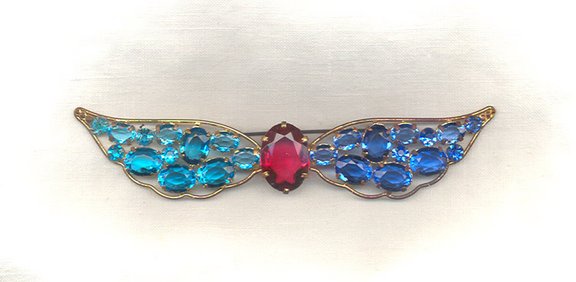
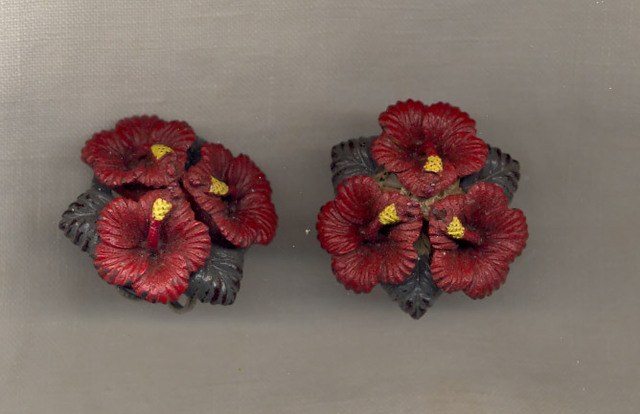
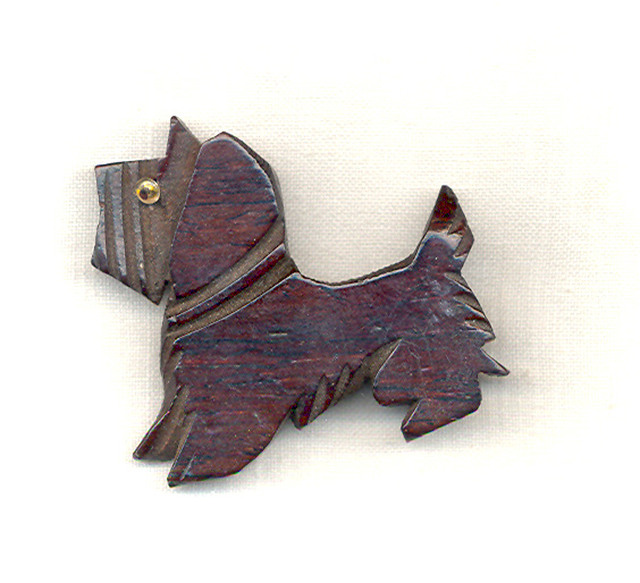
Here are some advertisements from the 1940's showing some changes from pre-WWI to the end of the decade and the New Look.
C. 1940 - Boucher:
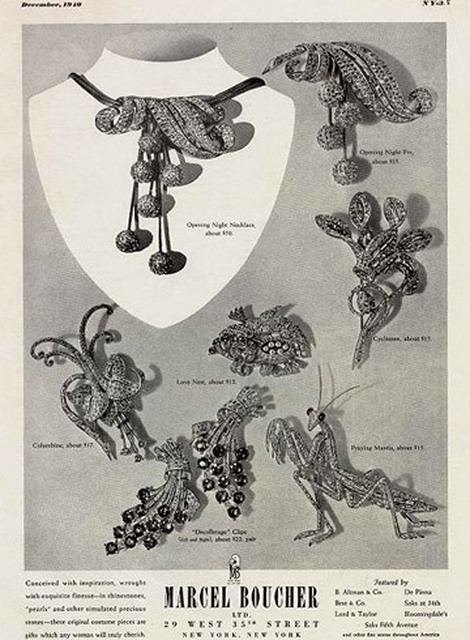
1941 Eisenberg:
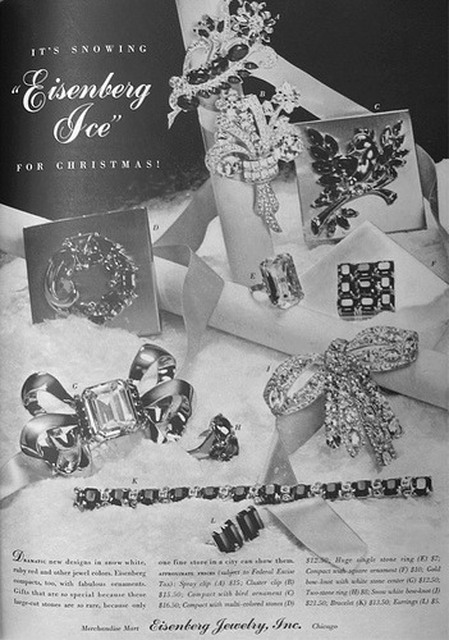
1943 - Eisenberg:
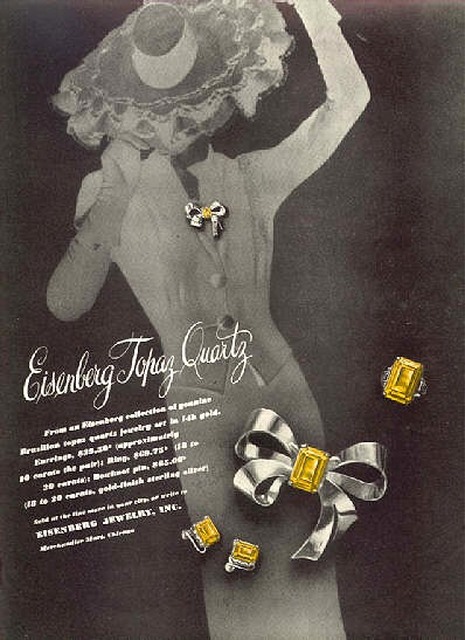
1944 Trifari:
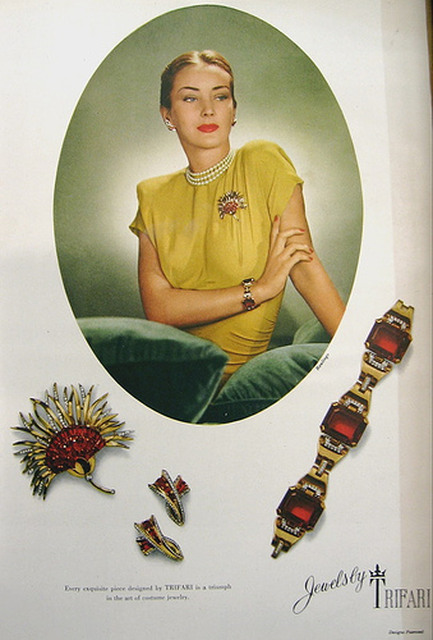
1945 Trifari:
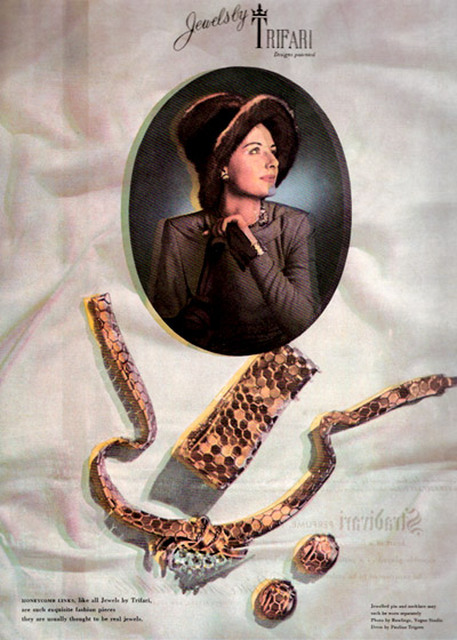
1946 Forstner:
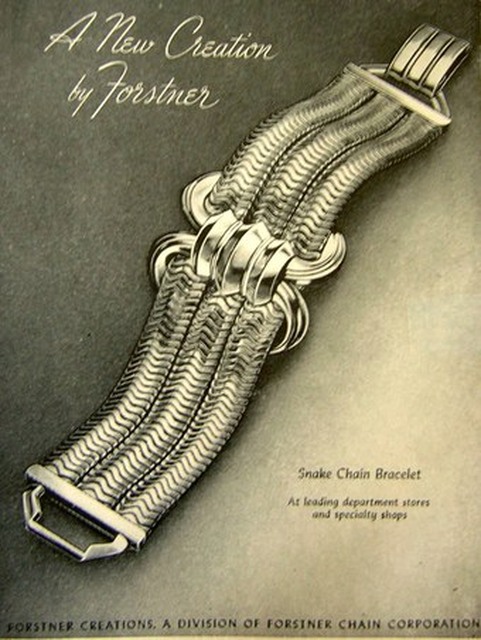
1946 Marvella
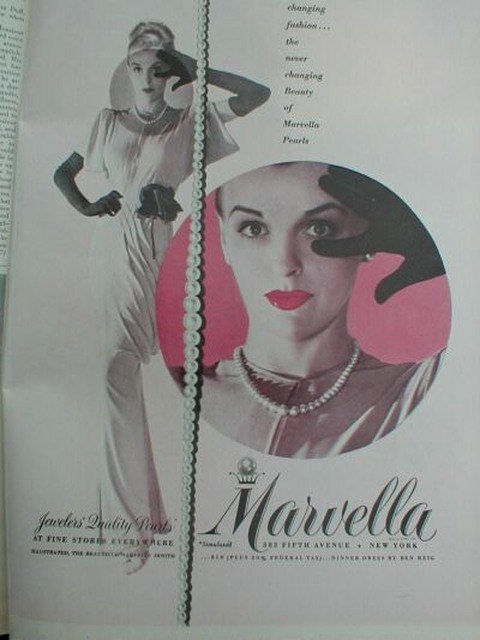 :
:
1947 Eisenberg:
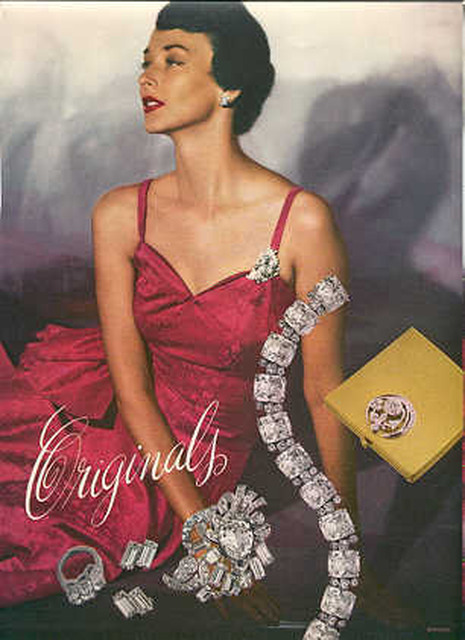
1948 Mazer:
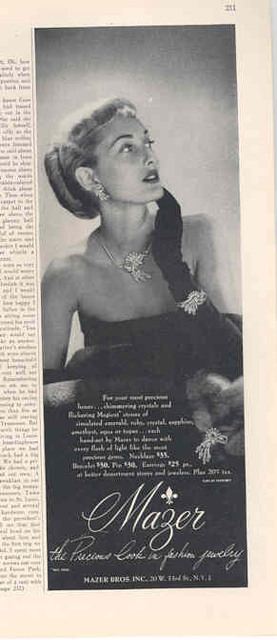
1949 Trifari and two pieces from the Meteor Collection:
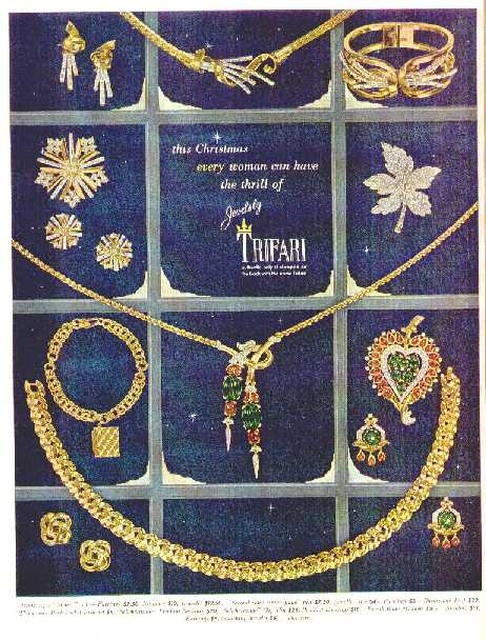
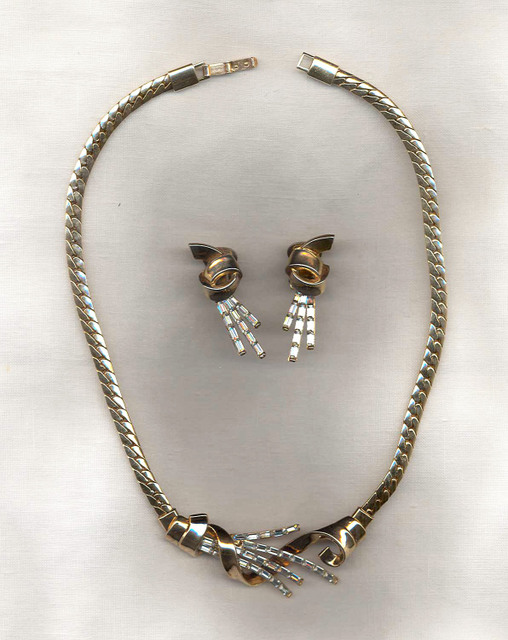
Mazer "Duchesse" 1949 - and the necklace:
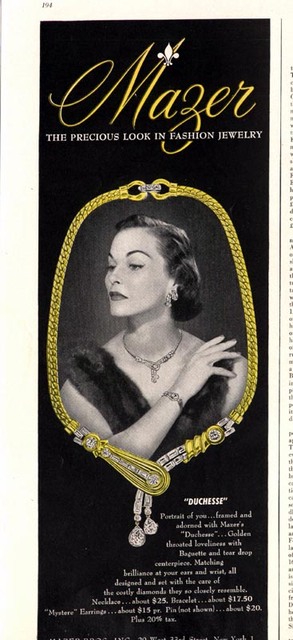
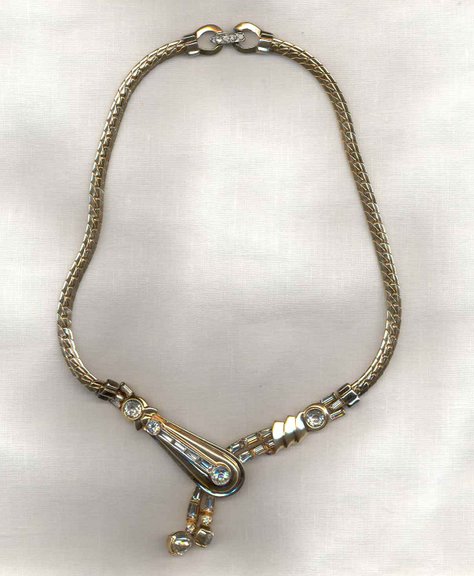
Here are a few more pieces of 1940's jewelry:
Unsigned - possibly Lisner:
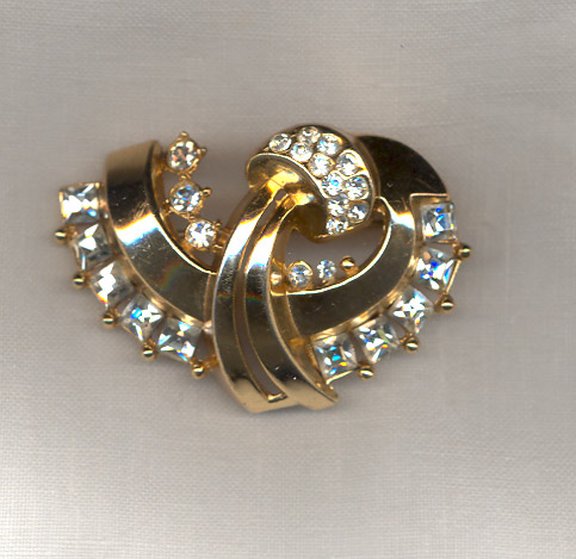
Harry Iskin:
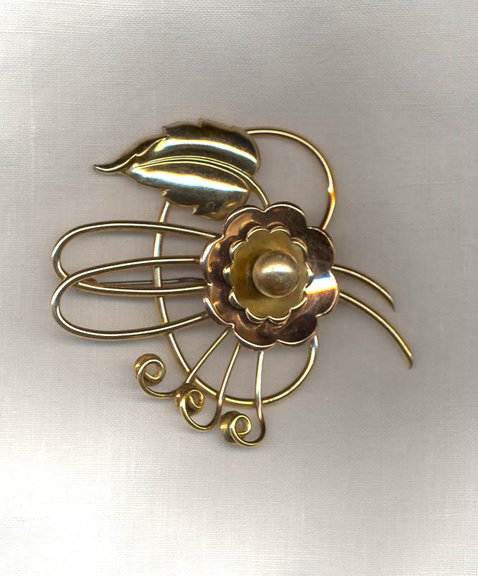
Coro Craft :
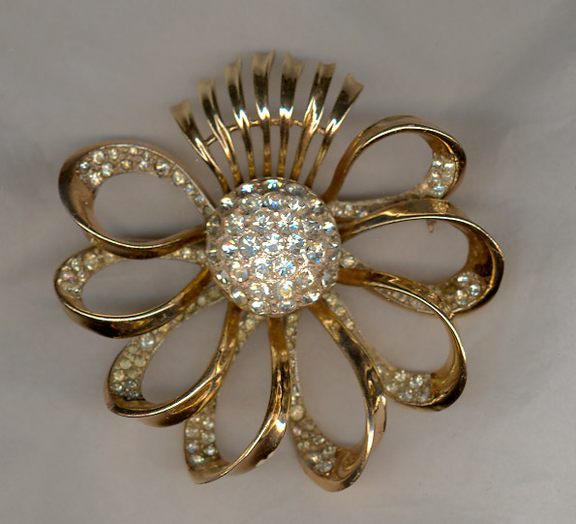
In Part IV we will finish the late '40's and discuss the late '50's - '60's.
Volutes, scrolls, spirals, domes, and stylized leaves and flowers were the dominant motifs. In about 1937, the supremacy of white metal came to an end and yellow gold came back into fashion on a large scale. However, white metal continued to be used including platinum (in fine jewelry and rhodium in costume jewelry) until it was restricted during the War years, and was used again when the restrictions were lifted.
This Coro "Duette" is in the Retro style:

Retro like Art Deco covers a number of different looks. It includes many of the floral enamels that were so popular in the late 1930's and early 1940's, the single large stone pieces, the streamlined gas pipe and tank designs that began prior to WWII and continued throughout the 1940's into the early 1950's. Many of the motifs that were seen both pre-WWII and post WWII are: pieces based on the Van Cleef & Arpels' “Honeycomb” Bracelets, Invisibly set brooches, and Flowerhead Brooches. The "Retro" style continued through the New Look, introduced by Christian Dior in the late 1940's, into the 1950's. The look appeared in fine jewelry and was interpreted in costume jewelry immediately!
During the 1930's several fine jewelry designers emigrated from Europe to the United States and worked for American jewelry companies. Marcel Boucher, who opened his own company in the late '30's worked for Mazer Bros. Alfred Philippe, the head designer at Trifari for many years came to the US from France. Providence, Rhode Island was the "capital" of American Jewelry Production during its heyday.
In the 1930's more and more jewelry designs were patented - which was meant to protect the design from being copied, but had little effect. However, it's a great way for us so many years later to date pieces - if we find a patent number on the piece.
When I first started collecting jewelry "seriously" I found a pretty rhinestone pin in a local antique shop. It was very inexpensive but it really appealed to me. After I got it home, I discovered it had a patent number on it. It's a 1941 rhodium plated Trifari brooch designed by Alfred Spaney. Here's my "great find" - and the patent:


Alfred Spaney was a free-lance designer who did some pieces for Trifari in the early '40's. Most of the Trifari patents are signed by Alfred Philippe who was the chief designer at Trifari for many years. Many of the Coro patents are signed by Adolph Katz who was the head of Design at Coro, but unlike Philippe, he was not a designer. Many of the best known Coro designs were done by Gene Verrecchia who was at Coro from 1933-1963.
In the late 1930's fashion changed - skirts became shorter, some pieces had shoulder pads and were very tailored while some pieces were highly romantic and "retro" in a different meaning of the word - influenced by "Gone With the Wind" which brought about a Victorian Revival in fashion and jewelry.
This is one of the few examples I have of Victorian Revival jewelry. It's a cross between Victorian and Retro in style. It was made by Kreisler and is signed Kreisler USA Quality.

In the very late 1930's - early 1940's costume jewelry makers started replacing dress clips with "pin clips" which are more commonly known as "Fur Clips." This form was used by Cartier in the late 1920's but was not used in costume jewelry until later. Fine jewelry still uses this finding on some pieces but in general it was only used in costume jewelry for a relatively short time and its heyday was the 1940's. Here is an Eisenberg fur clip - front and back showing the prongs:


Fur clips were worn on heavy clothing like suits, coats and some dresses. They were not worn on furs, despite the name - the sharp prongs would have ruined the pelts.
In the late '30's and '40's Costume jewelry still mimicked fine jewelry. Here's an Eisenberg ad from 1940:

This piece is not signed. It's a dress clip that reminds me of the jewelry shown in the previous ad:


I showed this Trifari Fur Clip, designed by Alfred Phillipe with the patent in the first part of this workshop but here it is larger:
This is D. 119,095 - February 20, 1940:

Here's the 1938 Trifari advertisement we looked at in in Part I, and a Coro brooch that is quite similar to those in the ad::


Another very "Retro" styled Floral enamel fur clip probably Coro:

One of my favorite late '30's enameled brooches. It is unsigned and a great example of the Retro style:

During the late '30's and the early '40's "most" of the jewelry made by the better known companies was signed with the maker's mark or signature - but not all. Trifari was first to advertise that their jewelry was signed. It's more difficult to find unsigned Trifari particularly after the very early '40's. But it is possible to find unsigned pieces by many of the other major companies. Experienced collectors recognize pieces by designs and by the findings - type of dress clip, fur clip, pin catches, etc.
This very large early '40's brooch is not signed but it is recognizable as a variation of a design by Marcel Boucher. It is very similar to the Fuchsia series that he did:

Much of the jewelry of the late '30's and '40's was gold toned. Some of the motifs began prior to WWII and remained popular until after the War. These two bracelets were made by Trifari. The first is signed KTF and was made prior to 1937. The red "ruby" rhinestones are an example of invisibly set stones. The second is signed Trifari. Both are based on the honeycomb design called Ludo Hexagone by Van Cleef & Arpels.


Military themed jewelry like tank bracelets were worn throughout the late '30's and '40's. Gas pipe chains were used both as bracelets and for necklaces. This Retro styled necklace is by Kreisler and is marked Kreisler, U.S.A.

A 1940's set by Boucher. The center part of the necklace is a fur clip that can be removed so the chain can be worn separately -and so can the fur clip!

A "tank" style bracelet. This was originally gold toned and has "lost" its plating! :

Here's another gold-tone '40's bracelet. The design is reminiscent of "tank tracks.":

WWII began earlier in Europe than in the US. Some of the raw materials for manufacturing jewelry were in short supply and after the entry of the US into the war, base metals and rhodium plating were restricted for war use. Jewelry was made from other materials. Fine costume jewelry was made of sterling silver which was not restricted, and was often plated, although not all was plated. Jewelry design changed to accommodate the restrictions. Pieces featured one large often unfoiled rectangular cut stone due to the shortage of Austrian crystal rhinestones. Here are some "Retro" brooches from the WWII era:
Note that some of these are in the Red White and Blue patriotic color combination that we discussed in Part I:
Mazer:


Trifari:


Eisenberg Original:

Monet:

Here's a Hobé Sterling piece:

During WWII some jewelry was made in the shape of animals or fish and featured large pieces of Lucite set in sterling. These pieces are now nick-named "Jelly Bellies." The Lucite was left over from airplane windshields! These are highly collectible:
This is a Trifari piece designed by Norman Bel Geddes. The wavy gold things are actually the refection of the fur clip mechanism:

Sterling continued to be used for a few years after the War.
Mazer - 1946

Here's an ad showing this piece and matching earrings:

You may have been wondering why we haven't seen very many matching "sets" or parures so far. The tendency to abandon parures started in the late 19C. and continued to the 1940’s. Pieces of the same style & materials, but not the same design were worn together. Parures were worn again in the 1930’s – but not in a big way. Matching sets came back on a large scale in the 1940’s.
Many vintage costume jewelry collectors have what is called SCS - "set completion syndrome" and look for all the pieces of a set - bracelet, necklace, brooch and earrings.
We haven't discussed fashion as much in this section as in previous sections. Most of you are aware that during WWII there were restrictions on how much fabric could be used so clothing that was produced either by manufacturers or at home was very influenced by wartime regulations. Again many women were in the work force - fashion was influenced by military themes and was shorter and straighter . Big shoulder pads were popular and some military motifs like epaulets were used. Woman also had to "Make do and Mend" - and older clothes were worn, shortened and stocking seams were painted on the back of the legs because nylon was used for parachutes.
People were very creative making do with jewelry as well. Jewelry was made of wood, plastic stones were used and due to the shortage of metal, even construction methods were altered. Here is a Miriam Haskell dress clip made of plastic.


In the first part of the workshop we looked at some patriotic jewelry from WWII. The plastic stones were used because the crystal and glass stones from Austria and Bohemia were unavailable due to the War. This airplane brooch has plastic stones:



Here are some advertisements from the 1940's showing some changes from pre-WWI to the end of the decade and the New Look.
C. 1940 - Boucher:

1941 Eisenberg:

1943 - Eisenberg:

1944 Trifari:

1945 Trifari:

1946 Forstner:

1946 Marvella

1947 Eisenberg:

1948 Mazer:

1949 Trifari and two pieces from the Meteor Collection:


Mazer "Duchesse" 1949 - and the necklace:


Here are a few more pieces of 1940's jewelry:
Unsigned - possibly Lisner:

Harry Iskin:

Coro Craft :

In Part IV we will finish the late '40's and discuss the late '50's - '60's.





